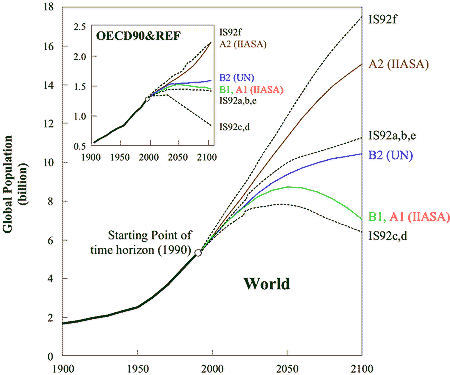Driving forces for emission scenarios
Driving forces for emission scenarios are the factors that influence how society will emit greenhouse gases in the future. There are a few main driving forces for emission scenarios, each of which impact greenhouse gas emissions. Emission scenarios take into account each driving force in different ways, resulting in unique scenarios of the Earth's future.
These driving forces are also factors in the Kaya identity, a metric used to determine carbon emissions.
The driving forces are:[1]
- Energy use - Currently the world gets most of its energy from fossil fuels, with a smaller mix of nuclear power and renewable energy. Different emission storylines follow the path of high fossil fuel use, while others assume minimal fossil fuel use.
- Economic development - The economy fluctuates on a daily basis, however general assumptions can be made for the long term future. One of which that is used in the scenarios is the narrowing of income differences among the world's regions. Since energy-use worldwide is affected largely by the economy, GHG emissions are as well.
- Technological development - Within the next 100 years there is no telling where technology will be. Technological advancements increase efficiency of processes, and could potentially result in lower GHG emissions depending on other factors.
- Population growth - There are many models of the world's future population, varying from 7 billion people to over 15 billion people by the year 2100. The most widely accepted models place the world population at just above 10 billion people by this time. The four families of scenarios (A1, A2, B1, B2) take different extremes into consideration, with lower population growth resulting in lower GHG emissions (see Figure 1 below). To learn more about the scenarios, see emission scenario.

References
- ↑ IPCC. (Accessed May 9, 2016). "IPCC Special Report on Emissions Scenarios" [Online], Available: https://www.ipcc.ch/pdf/special-reports/spm/sres-en.pdf
- ↑ IPCC. (Accessed May 9, 2016). "IPCC SRES Ch.8" [Online], Available: http://www.grida.no/publications/other/ipcc_sr/?src=/climate/ipcc/emission/014.htm

